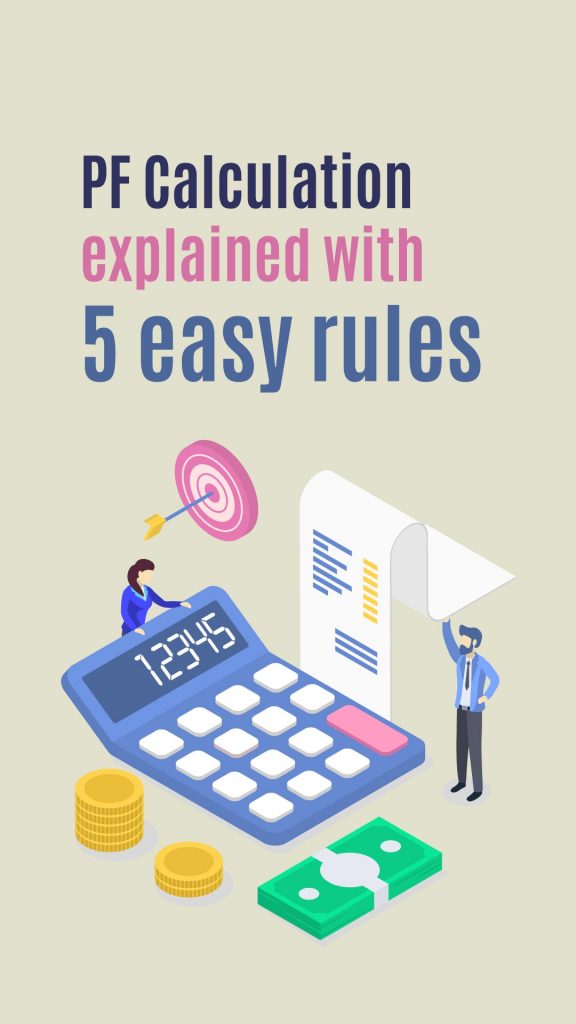This blog is like Dhoom 2 to our blog post on the EPF Act and amendments (the sequel 🙂 ). Here we will be discussing 5 must-know rules for EPF calculation. Like in the previous blog post, besides you’re a business owner, a CA, or an employee who qualifies for the EPF Act, these 5 rules can be life-saving!
We’ll be covering topics including:
- PF Calculation
- 5 Rules
- Working Examples
First, a recap of the EPF Act.
The EPF Act consists of :
- The Employee Provident Fund.
- Pension Scheme of the employee.
- The Employee Deposit Linked Insurance Scheme.
The EPF, EPS, and EDLI accounts have all the deposits separately.

Table of Contents
The 5 Rules for EPF Calculation
RULE 1: Source of Contribution for EPF Calculation
This rule states that all the deposits made into the PF account are from two sources- the employer and the employee. The employee’s contribution is taken directly from his salary, while the employer provides the rest.
RULE 2: Matching Deposits
This rule states that the contribution of the employee to the EPF account must be equal to the sum of the contribution of the employer in both EPF and EPS accounts.
For example, if the employee deposits INR 500 in the EPF account, the employer must also deposit INR 500, divided between EPF and EPS accounts.
RULE 3: Extra Amount by Employer
The employer only pays all the EDLI accounts and the EPF administrative charges. Why? Well, he’s the employer, so he has to pay some extra money right?
RULE 4: PF Wages for EPF Calculation
The PF is a deduction, not on your whole salary, but your (Basic pay + DA) only. This rule might be changed to include HRA in the future as well.
RULE 5: Wage Limit
As of September 2017, ONLY the employees with PF wages less than 15,000 are covered in the EPF Act. Once covered, even if their salary increases beyond 15,000, the PF will still be calculated at INR 15,000.
Contribution Rates for EPF Calculation
The contribution rates are different for the employee and the employer. The employee has to pay 12% of his/her PF wages, while the employer has to pay 13.15% of the employee’s PF wages. All of the employee’s PF wages go to the EPF account, while the employer’s wages are split into 4 different accounts. The breakup is given below.
Note that the EPF (Employee) = EPF + EPS (Employer)
| EMPLOYEE | ———————————————-EMPLOYER——————————– | ||||
| Regular Employees | 12% (EPF) | 3.67% (EPF) | 8.33% (EPS) | 0.5% (EDLI) | 0.5% (EPF Admin Charges)** |
| Some Particular Companies * | 10% (EPF) | 1.67% (EPF) | 8.33% (EPS) | 0.5% (EDLI) | 0.5% (EPF Admin Charges)** |
| Ages 58+ | 12% (EPF) | 12% (EPF) | – | 0.5% (EDLI) | 0.5% (EPF Admin Charges)** |
All numbers are rounded off to the nearest real number., The Admin charges have been reduced from .65 to .5%
* The particular companies will be explained in the next section.
** The EPF administrative charges have to be paid by the company to the government.
- If there is at least one employee in the company who is eligible for the EPF act, the charges have to be a minimum of INR 500. For example, if there are two employees whose admin charges are INR 200 each, the total charge is INR 400, which is less than INR 500. Thus, the company has to pay INR 500 for admin charges.
- However, if there is NO employee in the company who is registered in the EPF Act, therefore the admin charges are INR 75.
Which businesses have a 10% rate in EPF Calculation?
There are multiple cases where an establishment avails 10% rate:
- Companies with less than 20 employees who claim voluntary coverage receive a 10% rate. ( Not applicable now )
- In fields of companies that have been declared ‘sick’ by the board of industries and financial reconstruction receive a 10% rate.
- Companies where the financial year’s loss is greater than their net worth receive a 10% rate.
- Jute, coir, beedi, brick, guar gum, etc. industries are liable to a 10% rate.
A working example of EPF Calculation:
Assume an employee whose salary is Basic(10,000) + DA(2,000) + HRA(6,000) = 18,000. So, his PF wages will be INR 12,000.
Hence, he is eligible for the EPF act as 12,000 < 15,000.
Now, his PF breakup will be as follows:
| PF WAGES | EMPLOYEE | ——————————-EMPLOYER——————————— | |||
| 12,000 | 1,440 (EPF) | 440 (EPF) | 1000 (EPS) | 60 (EDLI) | 60 (EPF Administrative charges) |
Here too, note that EPF (employee) = 1,440.
EPF (employer) + EPS(employer) = 1,000 + 440 = 1,440
Now, the employee’s total savings are INR 2,880 (24%), while the total PF contributions are INR 3,000 (25.00%).
This 24% saved by the employee has a very high-interest rate of over 8%.
We genuinely hope you have learned something new from our blog, and stay tuned for more informative blog posts.
P.I. Jain and Company serve more than 500 companies across India and helps them with their payroll processing needs and EPF consultancy. We have been providing excellent PF Consultancy for over 40 years with hundreds of clients, and we look to expand further all over India.
Additionally, the Labour Law Advisor is also serving 300 learners with A to Z of PF compliance courses to make them understand the EPF act and its amendments in a more practical manner.



